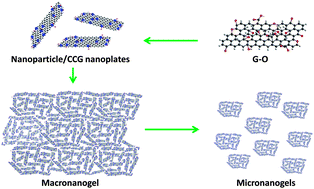Solution-processable conductive micro-hydrogels of nanoparticle/graphene platelets produced by reversible self-assembly and aqueous exfoliation†
Abstract
Preventing the π–π restacking of graphene-based platelets is essential to advance their fundamental attributes in a wide range of scalable chemical processes. Using macroscopic hydrogels of water-intercalated metal-oxide/graphene platelets is a novel approach to produce microscopic hydrogels with extraordinary surface accessibility and electronic properties. Nanoparticle decoration and surface hydration prevent irreversible π–π stacking, paving the way for reversible self-assembly and aqueous-phase exfoliation. The hydrophilic nanoparticle coating facilitates the colloidal stability of hybrid microgels in aqueous and organic media without the assistance of surfactants. This allows these materials to versatilely function as basic building blocks as well as applied nanomaterials in wet-chemistry applications. The preservation of unique properties of SnO2-decorated graphene platelets leads to significantly enhanced adsorptive and photocatalytic activities. By exploiting the fluorescence quenching effect, a dye–hydrogel complex can be utilized as a supramolecular sensor for sensitive DNA detection. This study also initiates an innovative synthetic strategy to synthesize high-quality graphene-based nanomaterials.


 Please wait while we load your content...
Please wait while we load your content...